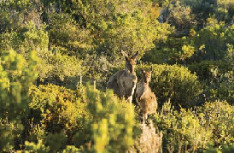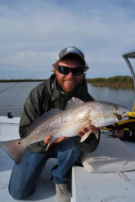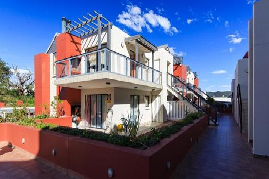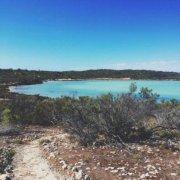Coffin Bay, South Australia 作者: 来源: 发布时间:2021-03-25
I. Population and Area
Total Area: 344.667 km²
Population in 2016: 611
https://www.whereis.com/sa/coffin-bay
II. Natural Geography
-Climate
Best Time To Visit Coffin Bay
Worried about tourists flocking or closing hours of Coffin Bay while planning your trip? The best time to visit Coffin Bay would be a time when you can completely soak in the experience and not worry about such hassles. The weather of Coffin Bay is favorable along with the best of activities during this particular time in Coffin Bay. If you are thinking about when to go to Coffin Bay then, come visit Coffin Bay at it's best time where you can make a memorable experience without having to worry about small issues.
Coffin Bay Weather in January-April: The air is slightly humid with average humidity being 68% and the average temperature is 67℉. The weather is perfectly balmy making it a great time to visit Coffin Bay. The maximum temperature recorded in this period is 102℉. An ideal season to visit Coffin Bay. The average precipitation recorded around this time is 1.98 mm.
Coffin Bay Weather in May: The highest temperature recorded is 73℉ which would make you want to run to the nearest café to down a glass of chilled drink, but the moderate humidity of 75% makes this month an excellent time to visit Coffin Bay. This time period sees an average precipitation of 39.77 mm.
Coffin Bay Weather in June: If you are contemplating the best time to visit Coffin Bay, the month of June fits the bill just right. The weather is nice and sultry with the lowest temperature being around 41℉ and the warmest being a usual 72℉. Albeit a humidity of 73%, June marks a good time to explore the best things to do in Coffin Bay. Expect an average precipitation of 7.4 mm.
Coffin Bay Weather in July-August: The time has been observed as the peak season to visit Coffin Bay and rightly so. The temperatures range between 39℉ and 72℉ and the humidity that has been observed to be a usual of 75% marking the perfect climate to head out and check out the best things to do in Coffin Bay. Expect an average precipitation of 14.08 mm.
Coffin Bay Weather in September-December: With average humidity of 69%, temperatures sway between 41℉ to 95℉. Now this may cause a little discomfort, but we are sure not complaining! This weather is perfect to go sightseeing around the city of Coffin Bay. This time period sees an average precipitation of 7.04 mm.
https://www.triphobo.com/places/coffin-bay-australia/best-time-to-visit
COFFIN BAY’S WEATHER
Coffin Bay experiences a delightful Mediterranean climate with summers in the high 20ºs, lovely autumns, ranging from high teens to mid 20ºs.
Winter temperatures are in the mid-teens, while spring is generally sunny with some afternoons being quite breezy, temperatures ranging from high teens to low 20ºs.
Average rainfall is about 500mm, falling mainly during the winter months.
https://coffinbay.net/welcome-to-coffin-bay/
-Geography
Our beautiful idyllic town of Coffin Bay, surrounded by sea and National Parks, overlooks the pristine waters of Port Douglas and Kellidie Bay, which are part of an extensive bay system that includes Little Douglas, Mount Dutton and Yangie Bays. In these bays, you will see numerous pods of dolphins whilst some of the islands are home to seals and sea lions and many breeding seabirds. Occasionally, you may even see a penguin.
Friendly kangaroos and emus roam the town with land and sea birds in abundance and magnificent wildflowers to be enjoyed.
Situated on the western tip of Southern Eyre Peninsula, Coffin Bay is 46 kilometres by road northwest of Port Lincoln. It boasts a steady growth in population and industry (aquaculture), with a permanent population of approximately 650, which swells to over 4,000 in the summer months.
Coffin Bay has an active commercial wharf in the town centre where you can watch the fishing boats unload their catches, including crayfish, pilchards, ocean jackets and sharks. There are also professional fishermen and abalone divers operating from the boat ramps. Their catches include octopus, sea urchins, sea snails, scallops, sand crabs, abalone, King George whiting and garfish. At the main boat ramp you will also see the oyster boats returning with baskets of the famous Coffin Bay oysters, from the many oyster leases within the bay system.
As the open ocean lies 21 kilometres from the town wharf, the many protected bays, channels and inlets offer ideal opportunities for fishing and all water activities.
Coffin Bay has all the facilities for you and your family to enjoy nature at its best.
https://coffinbay.net/welcome-to-coffin-bay/
-Transportation
Rome2rio makes travelling from Glenelg to Coffin Bay easy.
Rome2rio is a door-to-door travel information and booking engine, helping you get to and from any location in the world. Find all the transport options for your trip from Glenelg to Coffin Bay right here. Rome2rio displays up to date schedules, route maps, journey times and estimated fares from relevant transport operators, ensuring you can make an informed decision about which option will suit you best. Rome2rio also offers online bookings for selected operators, making reservations easy and straightforward.
https://www.rome2rio.com/s/Glenelg/Coffin-Bay
What companies run services between Coffin Bay, SA, Australia and Streaky Bay, SA, Australia?
There is no direct connection from Coffin Bay to Streaky Bay. However, you can take the taxi to Port Lincoln, take the bus to Cleve, take the taxi to Kimba, then take the bus to Streaky Bay. Alternatively, you can take the drive to Streaky Bay.
https://www.rome2rio.com/s/Coffin-Bay/Streaky-Bay
III. Economy

https://quickstats.censusdata.abs.gov.au/census_services/getproduct/census/2006/quickstat/UCL405000
IV. Industrial Characteristics
The small settlement of Coffin Bay then turned to another sea bounty: oysters. The first mention of the commercial exploitation of oysters near Coffin Bay appears in an extract of a letter from 28 April, 1848. By the following year, there was up to thirty cutters dredging the bay for oysters, and the settlement became known as ‘Oyster Town’. Huts were thrown up quickly for the fishermen’s families who had accompanied them to the area.
Dredging for oysters was a hard life. Fishermen worked from dawn to dusk, fishing through the day, then cleaning the shells of debris in the evening. Oysters were then bedded down, live, in the water, until the fortnightly market day, which transformed the town into a hive of activity. Wagons would drive down from Port Lincoln and fill up with oysters, eaten in Port Lincoln and brought further afield to Adelaide. More than 250, 000 oysters were brought from Coffin Bay every fortnight.
The sea could not keep giving. Oyster populations rapidly declined thanks to rapid overfishing. From 1882 to 1891 the lack of oysters led to an official closure of the oyster fishery, leading to the decline of the town. The native oysters never recovered, an issue of debate among marine biologists. Some suggest that the fishermen did not return their shells to the sea (as they would only dredge them up next time) – meaning that young oyster spat did not have a surface on which to attach and grow. The historic Oyster Town and whaling station are now an archaeological site – including the remains of several fisherman’s huts – which can be explored on the Oyster Walk.
In the 1960s, the Pacific oyster was imported from Japan via Tasmania, starting the current Coffin Bay oyster industry. Known nationally and internationally, contemporary Coffin Bay oysters are a testament to the richness of the environment for oyster growth.
https://www.odysseytraveller.com/articles/eyre-peninsula-south-australia/
Key Projects:
6. Coffin Bay
Pipeline complete at Coffin Bay
SA Water has completed a $3.5 million water supply upgrade for Coffin Bay, South Australia.
Local residents are now receiving water through an 18km pipeline which connects the town to the rest of the Eyre Peninsula water supply network and allows the region’s summit storage tanks to gravity-feed the town.
Installation of the pipeline began in mid-2014.
SA Water’s Senior Manager of Stakeholder Engagement, Matthew Bonnett, said some testing is still being undertaken, but water has begun flowing.
“The pipeline is capable of supplying up to 20 megalitres of water per year, depending on demand,” Matthew said.
“It increases the security and flexibility of the town’s water supply and assists in dealing with the increasing water demands in the area.”
“Based on our projections, the pipeline will be able to deliver additional capacity to support approximately 30 years of population growth in Coffin Bay.”
SA Water has also invested approximately $400,000 for the drilling of additional monitoring bores and mapping of the town’s groundwater supply.
“These investigations and monitoring will help us to further understand the local groundwater system and ensure the sustainability of Coffin Bay’s water supply,” Matthew said.
Following the completion of the water supply upgrade, an augmentation charge that was in place for Coffin Bay has been cancelled.
https://utilitymagazine.com.au/pipeline-complete-at-coffin-bay/
SA Water has announced a $3.5 million water supply upgrade for Coffin Bay.
The 18 kilometre pipeline connects Coffin Bay to the Eyre Peninsula water supply network.
SA Water chose the pipeline as the preferred option to increase Coffin Bay’s water capacity after also considering the expansion of the Coffin Bay borefield.
The pipeline option will increase the security and flexibility of Coffin Bay’s water supply by allowing the Eyre Peninsula’s Summit Storage Tanks to gravity-feed the town.
SA Water’s General Manager Commercial Business & Development Mark Gobbie says the pipeline will provide for future Coffin Bay population growth.
“The new pipeline assists in dealing with the increased water demands in the Coffin Bay area,” Mark says.
“It is projected the pipeline will deliver Coffin Bay additional capacity for approximately 30 years of growth. SA Water is now working with the local landowners whose properties lie on the pipeline route.”
Pending necessary native vegetation and cultural heritage approvals, construction is anticipated to commence mid 2014 and will be completed within the 2014/2015 financial year.
https://utilitymagazine.com.au/coffin-bay-sa-gets-new-pipeline/
V. Attractions
COFFIN BAY NATIONAL PARK
OVERVIEW
Known for its remote coastal scenery, the bays and coastline around the Coffin Bay National Park are ideal for boating, fishing, sailing, scuba diving and windsurfing. You can explore the park's coastal landscapes of high windswept cliffs and massive dunes, pounding surf beaches and sheltered sandy bays.
At the southern end of the park is Yangie Bay, accessible by 2WD. It’s an ideal place to paddle your canoe, enjoy a bush picnic or explore a coastal bushwalking trail. Point Avoid and Golden Island lookout can also be reached by sealed road and you’ll be rewarded with spectacular island views along the way.
The pristine northern beaches of Coffin Bay National Park are only accessible by high-clearance 4WD. A favourite destination for anglers, birdwatchers and surfers, this remote and beautiful area offers several secluded camping areas with easy beach access.
GPS enabled maps are available for this park, check the website for details.
Self-registration and payment for vehicle entry and camping is available at the park.
https://southaustralia.com/products/eyre-peninsula/attraction/coffin-bay-national-park
Coffin Bay National Park is a large national park on the west coast of the Eyre Peninsula in South Australia. It is 50 km (31 mi) west of Port Lincoln.[1] The park protects a range of different coastal areas including high cliffs, surf beaches, quiet bays and huge sand dunes. A large area of the park is on the Coffin Bay Peninsula. Much of the park is only accessible by four-wheel drive vehicles or boat.
Aboriginal stories say a great fire came from the ocean. Two men stopped the fire by dumping the sand dunes on top of it.
One of the trees found in the park is the Drooping Sheoak, Allocasuarina verticillata, and it is being replanted to restore some of the grassy woodlands.[2] Western Grey Kangaroos, lizards and emus can be found through the park.

https://wiki.kidzsearch.com/wiki/Coffin_Bay_National_Park
Oyster Farm Tours
Chuck on the waders, walk into the water and take a seat at the semi-submerged ‘Salt Water Pavilion’. You’ll learn about oysters, how to shuck them (and shuck your own) and taste them fresh out of the water.
Pure Coffin Bay Oysters Farm Tours
Learn about the industry from a farmer, eat freshly shucked oysters pulled from the ocean before your very eyes, and enjoy the clean air and waters of Coffin Bay as you cruise out of town.

GT Fishing Charters
Novice or pro, you’ll find something to suit you on this charter. From January to May, their Island Charter will take you to hook a Blue Fin Tuna, too!

Coffin Bay Boat, Water & Bike Hire
You can hire kayaks, stand up paddle boards and electric bikes – perfect for exploring Coffin Bay on land or sea.

EP Boat Hire
EP Boat Hire have three boats available for hire, for serious fishing or scenic viewing. Boats can be launched from Farm Beach, Coffin Bay, Mt Dutton Bay, Little Douglas and Port Lincoln.
Oyster Walk

Stretch your legs on this 15km trail – don’t worry, you don’t have to do it all – and enjoy the abundant flora and fauna and stunning sea views as you meander along the foreshore, up to the lookout and through to ‘Old Oyster Town’.
Yangie Bay Walks
Located in the Coffin Bay National Park and accessed by bitumen road, this is one of the most spectacular locations in the park. You’ll have seen it on social media! There are three trails accessible from the campground: the 2km Yangie Bay Hike, the 5km Yangie Island loop between vegetated sand dunes or for the more active, the 10km (one-way) Long Beach Hike.
Black Springs Well Hike
You will need a 4WD to get to the starting point of this trail, at the Black Springs camping area in the National Park. It follows the coast overlooking sheltered Port Douglas, and the full loop around is 2-3km.
Black Rocks Hike
For the dedicated hiker – trek to the rugged coastline of Avoid Bay, with views from sand dunes along the way. The full trip is 12.2km return, but you can stop at the first lookout point and make it a 7.5km return journey instead. The views are worth the walk.
https://www.eyrepeninsula.com/coffin-bay
VI. History and Culture
HISTORY OF THE NAME ‘COFFIN BAY’
Coffin Bay, 21 kilometres from the town of Coffin Bay, is part of the Southern Ocean. It was discovered by Lieutenant Matthew Flinders and his crew in the Investigator on the 16th February 1802.
On his return to England in 1810, he named the bay after Admiral Sir Isaac Coffin, who, as Resident Commissioner of Sheerness Naval Dockyards in England, had been responsible for the outfitting of Flinder’s ship the Investigator, for his imminent voyage to Terra Australis.
Due to weather conditions at the time, Flinders and his crew, did not go ashore although they did see the entrance to the bay system and noticed groups of Aborigines with fires on the beach. It was left to others to investigate these hidden bays many years later.
In March 1839, Captain Frederick Lees, in the brig Nereus, eventually charted these bays. The main bay was named Port Douglas, after Captain Bloomfield Douglas, who was Harbour Master in Adelaide at the time.
Evidence was found that whalers had been there as far back as 1804, in fact, rabbits were discovered in the area as it was common practice for whalers to leave rabbits as a food supply in the case of shipwreck or meat for future visits.
https://coffinbay.net/welcome-to-coffin-bay/history-of-the-name-coffin-bay/
DISCOVER COFFIN BAY: HOME TO A SMORGASBORD OF SEAFOOD AND WORLD-CLASS OYSTERS
At the southern tip of the Eyre Peninsula lies Coffin Bay, where pillowy sand dunes meet glassy waters brimming with fish and bushland teeming with wildlife. Just half an hour from Port Lincoln, there are literally hundreds of spots to throw down your beach towel around Coffin Bay. Discover pristine remote beaches, epic swells and secluded coves in Coffin Bay National Park ideal for boating, fishing and snorkelling. And did we mention oysters? In Coffin Bay, you can slurp what are arguably the best oysters in the world straight from the source as you stand in waist-deep in the turquoise waters of a working oyster farm with Pure Coffin Bay Oysters or stay on land and dig into oysters and local wine right on the foreshore with Oyster Farm Tours or 1802 Oyster Bar.
https://southaustralia.com/places-to-go/eyre-peninsula/destinations/coffin-bay
Discover Coffin Bay: famous for its oysters and spectacular fishing
Surrounded by sea and national parks, Coffin Bay is famous for its oysters, spectacular fishing, and is home to one of Australia’s most stunning estuaries. A popular holiday spot, and named after Sir Isaac Coffin (a friend of explorer Matthew Flinders), Coffin Bay’s calm, clear waters are perfect for sailing, swimming, kayaking, waterskiing and scuba diving.
A Recreational Fishing Paradise
Anglers will discover its meandering waterways, bays, channels and inlets are ideal for rock, surf and jetty fishing, while boaties have the choice of launching at four concrete launching ramps that are floodlit at night and protected by groynes for easier boat handling.
Apart from the fishing, cruising the waterways around the rugged islands off Coffin Bay will provide sightings of pods of dolphins, sea lions, fur seals and native birds. Don’t have a boat? Fishing charters can be arranged to offshore game fishing areas.
https://visitportlincoln.net.au/towns/coffin-bay/
Coffin Bay - Culture and History
Coffin Bay (including the Coffin Bay National Park, Wangary, Farm Beach and Gallipoli Beach)
Attractive and isolated holiday retreat on the southern tip of the Eyre Peninsula
Coffin Bay and the beautiful Coffin Bay National Park (which covers 29 000 ha of the peninsula) are located 703 km west of Adelaide and 47 km west of Port Lincoln. Coffin Bay is a typical Australian holiday resort (of the unspoilt variety) full of holiday units and relatively cheap accommodation and designed for people who want to spend a holiday fishing, sailing, skindiving, bushwalking or enjoying themselves on the beach. In recent times the calm waters of the bay have become enormously popular so that the population of the area, especially in school holiday time, is likely to increase from the small regular population of around 300-400 to over 3000.
https://www.traveller.com.au/coffin-bay?p=2
VII. Contact Information
Jo-Anne Quigley
Position
Mayor
District Council of Lower Eyre Peninsula
Address
24 Warrow Road
Cummins SA 5631
Contact
08 8676 2196 (Home)
mayor@dclep.sa.gov.au
0428 762 196 (Mobile)
Main Office
Open Mon-Fri 9am-5pm Railway Terrace, Cummins PO Box 41 Cummins SA 5631
Phone: (08) 8676 0400
Fax: (08) 8676 2375
Email: mail@dclep.sa.gov.au
Branch Office (Development)
Open to public 10am to 1pm, 2pm to 4pm 38 Washington Street, Port Lincoln PO Box 130 Port Lincoln SA 5606
Ph: (08) 8623 0600
Email: development@dclep.sa.gov.au
https://www.lowereyrepeninsula.sa.gov.au/council/contact-us/elected-members/quigley,-jo-anne
